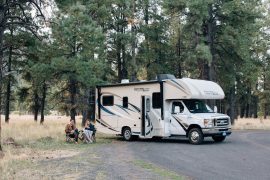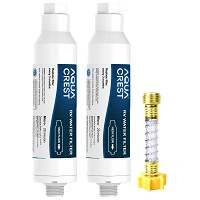When you are serious about the RV life, obtaining safe drinking water is not always an easy task. The quality of your drinking water is highly dependent upon the water source of any given RV park, unless you utilize pricey bottled water, instead. Either way, it’s a well known fact that water from plastic bottles, as well as RV park water sources are both accompanied by an unpleasant flavor.
How fresh is RV water, exactly?
By the time camping season is beginning to wrap up, water is drained out of the system in order to properly winterize your RV for winter storage. The biggest issue with this practice, is that it’s impossible to drain all of the fresh water from the holding tank. Should you manage to remove all of the water contained therein, moisture will still remain in the system. This means that it creates an environment beneficial to the growth of mold, mildew, and more. Next season, you will essentially be showering, washing dishes, cooking, and possibly consuming with water that sat all winter, accumulating contaminants.
In and of itself, contaminated water poses threats to your overall health. Regardless of whether contaminated water stemmed from winter storage, it is possible to receive water full of contaminants through hookups alone. There are simply zero guarantees when it comes to the safety of water originating from hookups in an RV park, so why bet your family’s health on something so controversial? The fact of the matter is, it is not uncommon to observe suspended particles and cloudy water flowing from RV faucets utilizing a hookup. And, in the moment, you have no way of knowing what’s in there!
What’s the resolution?
Water Filters
Water filters are one of the easiest ways to obtain safe and healthy drinking water. You may choose from a variety of styles, sizes, and features, according to what best suits your needs. Whether you prefer to attach one directly on your faucet, set something on a counter, or keep it in the fridge, you can bet there is one for you. Filter cartridges work by removing contaminants and solids through the use of activated carbon. This ensures your drinking water is free of bacteria, viruses, suspended solids, and dangerous chemicals, while also being abundant with essential minerals commonly found in drinking water.
If you find yourself concerned that simple cartridge filtration won’t be adequate for various water sources, an inline system, Reverse Osmosis, or Ultrafiltration system may serve as the best solution. These types of water purification utilize porous membranes to remove dangerous contaminants on a molecular level. RO systems also enable users to install prefilters for hard water, and subsequent stages for more refined filtration, such as for the removal of fluoride.
Bottled Water
Although it may seem convenient to grab a case of bottled water at the store, it’s rather bothersome to tote and store on your RV. Let’s not forget that the plastic used to produced bottled water also presents health issues in and of itself. When exposed to the heat of manufacturing and shipping, the plastic may leech dangerous chemicals into the contents and, ultimately, into your body. Long term, this “solution” is far from it, and shouldn’t be considered permanent.
The biggest issue with bottled water also comes down to the source. While bottled water manufacturers hinge their advertising schemes on crystal clear streams, and glistening rivers, it couldn’t be further from the truth. The fact of the matter is that bottled water is often produced utilizing municipal water sources, or even recycled wastewater. In that case, what’s the point of even investing in a different source from RV park water hookups?
Boiling Water
In the event of an emergency, when forms of purified water are otherwise unobtainable, it may be possible to boil your water source, instead. This method is ideal for situations where water may be unsafe to consume, for various reasons. This is especially true if you are utilizing a natural water source, such as a lake, river, etc. Regardless, boiling water may be the only situation for a variety of cases. However, it’s important to note that the act of boiling water does not remove contaminants, and does not have the innate ability to kill off every type of dangerous bacteria or virus. If you have no other choice, boil your water, otherwise, look to filtration or a purification system before a bad situation presents itself.
Filling the Tank
A great option is to ensure your tank is filled with fresh water before you even move your RV off the lot. You never know when you’ll reach a reliable water source before reaching any given destination. Whether you are traveling to the next campground on a vacation, or are moving from one RV park to another, you could face a water shutoff at any point.
It is important to keep your system sanitized as well. This further minimizes the risk of contaminants after winter storage, where leftover moisture could pose a health problem. Simply begin by draining the old water, through the use of a drain plug or petcock. It is important to note that you should never drain a water heater when it is under pressure, or otherwise hot. Continue by locating the drain for the fresh water holding tank, draining all of the contents. This is the time to turn the water pump on for a moment, in order to force out any remnants before closing your drains. However, once the water is finished draining, do not allow the pump to continue running.
A cup of household bleach per fifteen gallons, is all you need to sanitize the tank. Mix the bleach with water in a one gallon container, pouring it directly into the fresh water holding tank. Once it’s nearly full, turn the pump on, and open every single hot and cold faucet. This allows the water to run until you smell bleach. At this point, close your faucets. It’s important to drive your RV or trailer around, so the water can move around, further assisting with the complete sanitizing of the tank, if possible. Allow the RV to sit for 12 hours, before draining the entire system. You will want to fill the fresh tank with water once again, opening each faucet to allow water to run through. Once the smell of bleach is gone, you’re done. It may be necessary to repeat the process if you are unable to eliminate all signs of bleach. Once the smell is gone, though, you are free to use the water system.
Add Flavor
Water tanks can leave your drinking source tasting funny. Filtration and boiling won’t always be the solution, which is where the addition of flavor may be a lifesaver. In the event of unpleasant water, simply utilize flavors such as lemonade mix, or even add water for an infused treat. This way, you’ll stay hydrated, and be free to enjoy the rest of your space in a beautiful environment.
Final Thoughts
Water is one of the most important aspects to good health. Without a good, reliable source of water, hydration may not be possible. It’s for this reason that we suggest the aforementioned resolutions to handling a frustrating water source situation. By adhering to the advice above, you will be well on your way to enjoying your RV, regardless of where life takes you.

